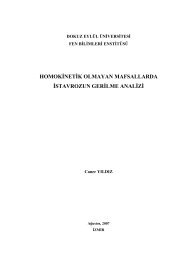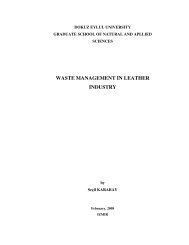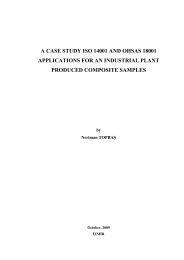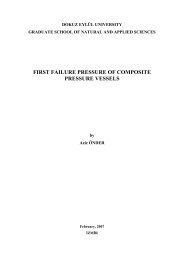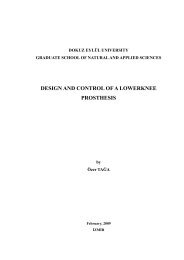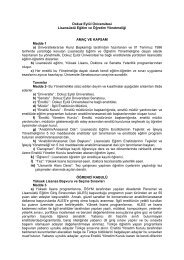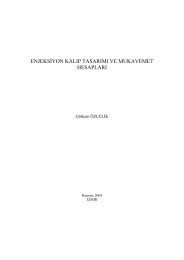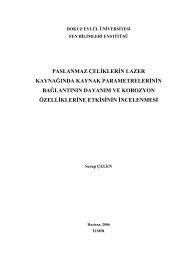A numerical study on the thermal expansion coefficients of fiber
A numerical study on the thermal expansion coefficients of fiber
A numerical study on the thermal expansion coefficients of fiber
Create successful ePaper yourself
Turn your PDF publications into a flip-book with our unique Google optimized e-Paper software.
38<br />
• The composite is macroscopically homogeneous and orthotropic, linearly<br />
elastic, initially stress free, and free <strong>of</strong> voids. There is complete b<strong>on</strong>ding at<br />
<strong>the</strong> interface <strong>of</strong> <strong>the</strong> c<strong>on</strong>stituents and <strong>the</strong>re is no transiti<strong>on</strong>al regi<strong>on</strong> between<br />
<strong>the</strong>m. The displacements are c<strong>on</strong>tinuous across <strong>the</strong> <strong>fiber</strong> matrix interphase<br />
(<strong>the</strong>re is no interfacial slip).<br />
• The <strong>fiber</strong>s are homogeneous, linearly elastic, isotropic or orthotropic,<br />
regularly spaced, perfectly aligned, circular in cross secti<strong>on</strong>, and infinitely<br />
l<strong>on</strong>g in <strong>the</strong> l<strong>on</strong>gitudinal directi<strong>on</strong>.<br />
• The matrix is homogeneous, linearly elastic, and isotropic.<br />
• The temperature is uniform and remains uniform during <strong>the</strong> temperature<br />
increase. C<strong>on</strong>stituent material properties do not vary with temperature.<br />
3.4.1 Some <strong>of</strong> <strong>the</strong> Existing Theories<br />
C<strong>on</strong>sider a random two-phase composite. Assuming that <strong>on</strong>e <strong>of</strong> <strong>the</strong> phases,<br />
subscript f, is dispersed in a polymer phase, subscript m, and α m > α f , where α is <strong>the</strong><br />
<strong>the</strong>rmal expansi<strong>on</strong> coefficient <strong>of</strong> <strong>the</strong> phases. When such a composite is heated, even<br />
under c<strong>on</strong>diti<strong>on</strong>s <strong>of</strong> no external loading, <strong>the</strong> matrix will wish to expand more than <strong>the</strong><br />
fillers and if <strong>the</strong> interface is capable <strong>of</strong> transmitting <strong>the</strong> stresses which are set up as a<br />
result <strong>of</strong> differences between <strong>the</strong> <strong>the</strong>rmal expansi<strong>on</strong> <strong>coefficients</strong> and elastic c<strong>on</strong>stants<br />
<strong>of</strong> <strong>the</strong> c<strong>on</strong>stituents so that <strong>the</strong> expansi<strong>on</strong> <strong>of</strong> <strong>the</strong> matrix will be reduced. These <strong>the</strong>rmal<br />
stresses cause stress c<strong>on</strong>centrati<strong>on</strong>s which may initiate yielding or deb<strong>on</strong>ding.<br />
Therefore, in design analysis, it is important to understand how <strong>the</strong>se stresses arise<br />
and how to c<strong>on</strong>trol <strong>the</strong> <strong>the</strong>rmal expansi<strong>on</strong> <strong>coefficients</strong> <strong>of</strong> <strong>the</strong> composite. In <strong>the</strong><br />
<strong>the</strong>oretical treatments to be described, except for <strong>the</strong> equati<strong>on</strong>s <strong>of</strong> Sideridis (1994), it<br />
is assumed that <strong>the</strong> adhesi<strong>on</strong> at <strong>the</strong> interface is adequate to withstand this task.<br />
3.4.1.1 Law <strong>of</strong> Mixtures<br />
If each phase is assumed homogeneous and isotropic and linearly elastic over a<br />
small range <strong>of</strong> volumetric strains, in <strong>the</strong> absence <strong>of</strong> <strong>the</strong> phase interacti<strong>on</strong>, <strong>on</strong>e may






